Menus
The H2 Monocoque
Pilot-engineers are a rare breed, especially those who are equally expert in both disciplines and able to design innovative and unique solutions at the highest level and then pilot them successfully. the paragon of these talented virtuosos. By personally designing the John Player Norton he led to the Isle of Man victory in the TT F750 in 1973, he secured his place in the record books forever..
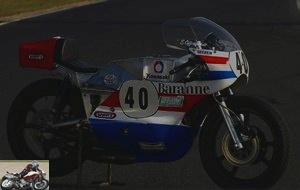 Offenstadt Kawasaki 750 review
Offenstadt Kawasaki 750 review
Genesis
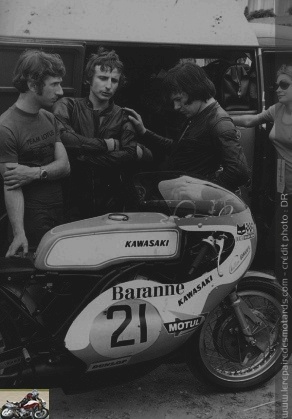 But there is another figure, less known outside of his native France, who deserves the same admiration, especially since he was racing the GP 500 with his own motorcycle, two years before Williams’ first Norton monohull was released. makes his first turn of the wheel. This man is Eric Offenstadt, known by all as Pepe and who turned out to be even more versatile than Williams..
But there is another figure, less known outside of his native France, who deserves the same admiration, especially since he was racing the GP 500 with his own motorcycle, two years before Williams’ first Norton monohull was released. makes his first turn of the wheel. This man is Eric Offenstadt, known by all as Pepe and who turned out to be even more versatile than Williams..
Indeed, his motorcycle pilot career was enriched by his racing career with his participation in F2 / F3 car races for teams as famous as Matra and Team Lotus with which he notably managed to beat future champions Jackie Stewart and Jim Clark. But he missed the motorbike and returned to motorbike racing 8 years later..
Pepe’s decision to return to motorcycle racing was taken following a chance meeting with an old friend at Stand 14 in Paris, in front of the butcher’s shop of Jean-Pierre Beltoise’s father where all Parisian riders used to go out..
During his car career, his friend Xavier Maugendre founded the SIDEMM company in 1968 and became the importer of Kawasaki. To promote the brand, he created the Kawasaki Cups which allowed many riders to hatch (Pons, C. Sarron, Fontan …), but also set up a team with Daniel Baranne to field two Kawasaki H1Rs in GP500. Maugendre then convinced Offenstadt to return to competition in 1971 alongside rising star Christian Ravel. Ravel and Offenstadt then chained the problems on the new H1R. But this did not prevent them from a few brilliant shots in GP with Ravel’s 2nd place at Francorchamps behind Agostini, his French Championship title or 4th place from Offenstadt to Imatra, as well as the victory of the two men at 1.000 km from Le Mans.
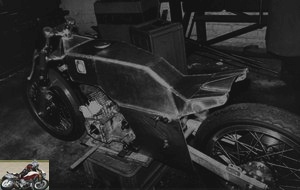 Offenstadt’s monohull frame takes shape for 1971
Offenstadt’s monohull frame takes shape for 1971
The handling and fuel economy issues of the H1R convinced Offenstadt to build a new motorcycle with a monocoque frame:
I have been surprised at how little technological progress has been made in racing motorcycles during the eight years that I have moved away. The best car I have ever driven was a Lotus monocoque that Colin Chapman had designed and developed in front of my eyes. It made sense to adapt it to motorcycles. Santiago Herrero was winning races in 250 GP on the Ossa monocoque, so the logic was to use the tank as a frame for the Kawasaki, which would allow me to carry more fuel and improve mass centralization, as well as stiffen the frame and hopefully improve handling.
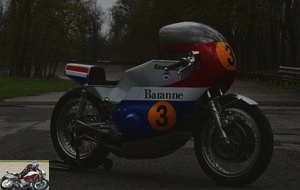 1971 Offenstard Kawasaki 500
1971 Offenstard Kawasaki 500
The season was marked by the success of the machine with several podiums, but also the death of Ravel, just ahead of him, at Spa-Francorchamps. In 1972, Eric continued his journey, but suffered from engine reliability problems. In the winter of 71-72, he created a smaller, low and light version of the monocoque chassis, with a tank reduced to 24 liters to meet the new Formula 750 regulations that had just arrived:
The H1R engine was not good. It vibrated a lot, was quite fragile and there was no further development to come on it. The new 750cc H2 was something else, it was a fabulous engine. So when they announced the start of Formula 750, I decided to build a bike around that to compete in the Daytona 200 and all the other European events for that category..
Discovery
Powered by a modified version of the all-new Kawasaki H2 750 Mach IV which had just been released in September 1971, Offenstad took the start of the 1972 Daytona 200 with the support of SIDEMM and Baranne riding a motorcycle painted in the colors of the flag. French. Just a week before the bike left for Florida, it was 250 World Champion Phil Read who tested the 750 monohull on the Paul Ricard circuit. But the cold and wet weather prevented Phil from passing judgment on the bike before he too took the road to Daytona where he will finish 4th with the John Player Norton..
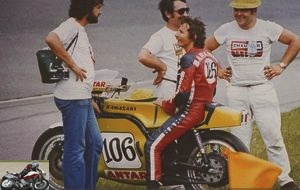 Offenstadt on the handlebars of his 750 during the Daytona 200 in 1973
Offenstadt on the handlebars of his 750 during the Daytona 200 in 1973
The smaller and lower F750 monocoque frame weighed just 12kg and was reinforced to provide more rigidity and strength than its taller and wider predecessor, with the engine mounted on Silentblocks directly at the rear of the monocoque with a pair of aluminum tubes coming down from the steering column. The more compact motorcycle weighed only 129 kg dry, which is 9 kg less than the original H2R. Its thinner front end also ensured better top speed, a crucial point in Daytona curves..
 Thanks to its monocoque frame, the bike weighs only 129 kg dry
Thanks to its monocoque frame, the bike weighs only 129 kg dry
The bike was fitted with a 41mm diameter Rickman fork set at a 29 ° caster angle and adapted to support two single piston Honda CB750 calipers and a pair of 298mm Kawasaki discs, with rear a third disc / caliper duo. Initially, it was fitted with spoked rims, but these were later replaced by SMAC aluminum rims. Likewise, the brakes were replaced with Lockheed calipers and SMAC discs..
 The original brakes were replaced with Lockheed calipers and SMAC discs
The original brakes were replaced with Lockheed calipers and SMAC discs
Offenstadt himself modified the 748cc air-cooled, 71 x 63mm H2 three-cylinder engine to deliver what he rated as 75 horsepower on the rear wheel at 7,500 rpm. The engine was fitted with Kr ignitionöber and a trio of 35mm Mikuni VM35SC carburetors from the H1R. However, in order to allow the modified H1R exhausts to cross each other, the two outer cylinders were swapped so that the exhaust ports point in the correct direction. This, however, resulted in cylinder outer flanks without fins and this arrangement unfortunately caused overheating problems. Problems that will be partially resolved via internal ducts before the restored cylinders are returned to their original places.
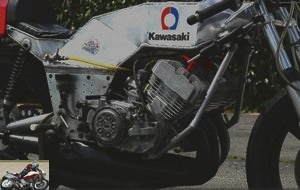 Modified, the H2 engine here develops 75 horsepower
Modified, the H2 engine here develops 75 horsepower
The dry clutch and five-speed gearbox were both from Team Baranne’s J1R, mated to an original H2 primary drive. The final chain drive used a roller to ensure constant tension while the motor was mounted further forward and lower than the hubs than in the stock H2. Again, the goal was to improve the center of gravity of the monocoque frame as well as to put more weight on the front wheel for better grip. The double Ceriani shocks originally fitted to the tubular steel swingarm were later replaced by the current Koni, with a wheelbase of 1,400 mm.
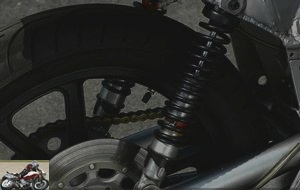 Koni shocks are adjustable in preload
Koni shocks are adjustable in preload
In the saddle
Although I was living in Paris at the end of 1969, I had never seen the Offenstadt Kawasaki monocoque in action at the time. But a chance meeting allowed me to fill this gap. When Gilles Hampe arrived at the Coupes Moto Legende in 1999 in Montlhery and parked next to it, he then unloaded the unique Kawasaki 750 Offenstadt that he had restored the previous year to allow Éric to drive the Centennial TT from Assen. We then rode together during the "parades" (which are not), him on the Offenstadt and I alternating on the Suzuki RG500 XR14 of Barry Sheene and on the Kawasaki KR500 of Kork Ballington. As we parted ways, the quadruple winner of the Bol d’Or Classic on Godier Genoud Kawasaki (3 successes with Christian Haquin and one with Alain Genoud in person) said the magic words:
Would you like to come and test the Offenstadt one day? If so, maybe we could ask Eric to be there ?
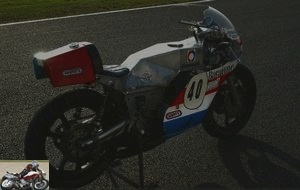 The Offenstadt Kawasaki 750
The Offenstadt Kawasaki 750
It took a while to get done, but a few years later, we met on the other circuit in Paris, the short and tight Carole circuit. And yes, Eric Offenstadt was there in person to tell me the story of this motorcycle..
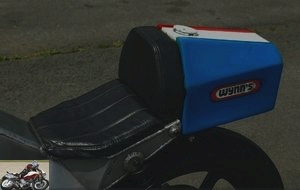 The seat is lower than on many sports cars of the time
The seat is lower than on many sports cars of the time
As I climbed into the saddle, I immediately sensed that the Baranne sponsored Kawasaki monohull painted in its patriotic blue-white-red livery was quite different from other early ’70s motorcycles I had ridden. The fairly low saddle gives the impression of being seated in the motorcycle rather than on it. An ideal configuration for Daytona turns where the fairly large fairing makes perfect sense. However, although undeniably lowered, so that one is invited to wrap around the aluminum monocoque tank, the Offenstadt seems balanced, without that typical architecture of many sports cars of the 70s. very good handling in Carole’s many bends and where the weight distribution does not disturb the steering or make it understeer, even when the throttle is opened.
Test
The weight also seems very reduced, the bike weighing only 129 kg when dry and placed low. The motorcycle is therefore very easy to move from one angle to another. This low center of gravity was also supposed to help the bike’s stability over the Daytona bumps..
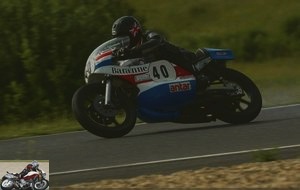 With its low weight the motorcycle is very agile
With its low weight the motorcycle is very agile
However, I was disappointed with the brakes. Okay, there’s not a lot of weight to stop and Carole doesn’t get up to Daytona speeds, but still the initial bite is light and you have to squeeze the lever hard to slow the bike down before you go. ” approach the hairpin turns at the end of the two straights. I initially assumed it was because these brakes included aluminum discs that SMAC was producing at the time, which like the similar Hunt’s on Agostini’s MV, provided certain advantages in terms of weight and weight. gyroscopic effect, but required calipers that worked very well, which was not the case here. I was therefore surprised to learn from Gilles that they were in fact 260 mm SMAC steel discs bitten by Lockheed calipers because this package should rather be compared to that of the top of the Ducati Paul Smart victorious in the Imola 200, a race Offenstadt had led before slipping on an oil trail. Clearly the feeling is not the same.
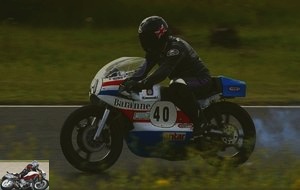 Braking is clearly behind the rest
Braking is clearly behind the rest
Offenstadt’s bike is very rational in its handling, even if it is slightly narrow for me since it was tailor-made for Eric, who is shorter. How Gilles was able to ride the motorcycle from the height of his 1m90 remains a mystery! But the bike inspires confidence and the cocktail of tires with a Dunlop KR124 at the front and an Avon AM23 at the rear works perfectly..
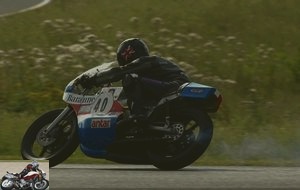 The tires grip well and the bike quickly builds confidence
The tires grip well and the bike quickly builds confidence
The arrival of power is relatively smooth and predictable and, thanks to the mounting of the engine on Silentblocs in the frame, with very little vibration. Gilles did a good job rebuilding the engine! It’s a smoother engine than the H1R’s. I drove Ginger Molloy’s from the 1970 World Championship and this 750 H2 engine is both more torque, as you would expect, but also smoother. The power delivered is sharp around 5,000 rpm and there is good acceleration from 5,500 to 7,000 rpm, but then it stops firing when it should exceed 8,000 rpm.
We tried different settings to no avail, so I had to work a bit more on the gearbox to stay in high revs, which isn’t really complicated on a short circuit like Carole..
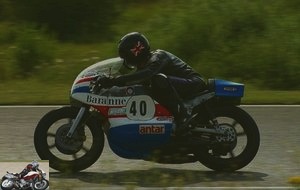 The three-cylinder can be operated between 5,000 and 7,500 rpm
The three-cylinder can be operated between 5,000 and 7,500 rpm
The cable clutch is a bit stiff with the springs that Gilles installed, but it remained perfectly manageable even if it is quite difficult at start-up and a real talent is needed to synchronize the throttle opening at engine speed..
Conclusion
My main admiration after I finally got to ride this Offenstadt monohull is for the quality of the bike’s steering, as well as the very practical riding position, although Eric is shorter than me. Compared to the downright odd stance of the TT-winning monohull JPN with close-knit hands to reduce the frontal area and which I have been lucky enough to ride a number of times, the Offenstadt Kawasaki 750 is welcoming and rational. Well done Eric !
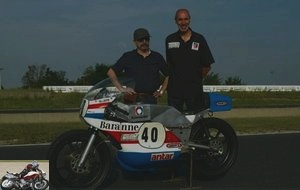 Eric Offenstadt and Gilles Hampe with the 750 monohull at the Carole circuit
Eric Offenstadt and Gilles Hampe with the 750 monohull at the Carole circuit
Strong points
- Maneuverability
- Driving position
- Suspensions
Weak points
- Braking
- Clutch
Offenstadt Kawasaki 750 technical sheet
Related articles
-
The last of the line The ultimate expression of ELF’s motorcycle design philosophy was the ELF5 , itself an evolution of the unsuccessful ELF4 and which…
-
Martin Kawasaki 1230 Motorcycle Test
The faithful friend 4 Z1000 cylinders rebored to 1,229 cm3, 144 hp, Moto Martin frame, 175 kg dry Many of us have had motorcycles that have become…
-
The first two-stroke of the Grands Prix 500 3-cylinder engine, 498 cm3, 82 hp and 59 Nm, 134 kg dry Ironic, really. Of the four Japanese manufacturers,…
-
Kawasaki 1400 GTR motorcycle test
THE GT There always comes a time when every motorcyclist wonders about the positioning of his passion. And the current offer, with its various…
-
Kawasaki Z1B Moriwaki motorcycle test
Wild and brilliant roadster 4 cylinders in line, 1,135 cm3, 119 hp, 160 kg It has been exactly 40 years since New Zealander Graeme Crosby entered the GP…
-
Kawasaki Z H2 Supercharged motorcycle test
200 hp, 14 mkg at 8,500 rpm, 239 kg all full, 17,099 € Put some salt ! Fifteen days of driving with the Kawasaki Z H2? I say it bluntly, it takes less to…
-
The European Grand Prix prototype 108 ° V4, 499 cc, 192 hp at 12,500 rpm, 129 kg We find it normal to see Ducati, KTM and Aprilia currently competing in…
-
Kawasaki Ninja ZX-10R KRT motorcycle test
An integer character 4 cylinders in line, 998 cm3, 203 hp, 114.9 Nm, 206 kg all full facts, 18,099 euros. Nice surprise for me to find the Kawasaki…
-
2012 Kawasaki ER-6n motorcycle test
New test: Kawasaki ER 6N: Sparkling with mischief ! Appeared in 2006 and restyled in 2009, the ER6 N gets a new facelift that makes it even sexier,…
-
Revelation 998 4-cylinder compressor, 998 cm3, 200 hp, 137 Nm of torque, 239 kg, 17,099 euros The Roadster era, a heated era in the motorcycle timeline,…
On my Stelvio, the heat given off by the cylinders is only annoying by very high heat and low speed. This summer, while traveling in the Perigord with temperatures of 35 to 38 ° C and often congested traffic, I suffered for the first time from the rise of heat on the shins and knees but it was still very bearable. In these conditions, many motorcycles release too many calories to the rider.
Franck
It’s a shame that this kind of development hasn’t had a real impact on mainstream motorcycles..

We are always behind us…
ah I recently own a 1200 sport 4v the indestructible.
what the sound
get it right while respecting the speed limits
AWESOME
Honest essay,

even if the two faults noted are due, one, to the temperature, to the extreme youth of the tested model (this type of engine begins to free itself, and therefore to heat less towards 7/8000 km), the other, suspensions lack of adjustment. For example, in order not to widen in the curves, you really have to raise the rear by increasing the preload and you have (almost) a bike that dives to the rope and stays there as you wish..
Otherwise, I am amazed like my little comrades that the fork does not have compression and rebound adjustment … Can the 4v owners confirm or deny??
Finally, it is true that the Sport, in 2 as in 4v, can be difficult to follow if it is carried out well, it just takes a little practice.!